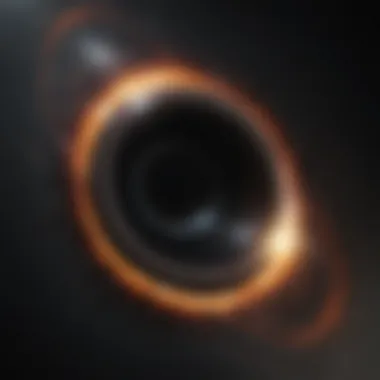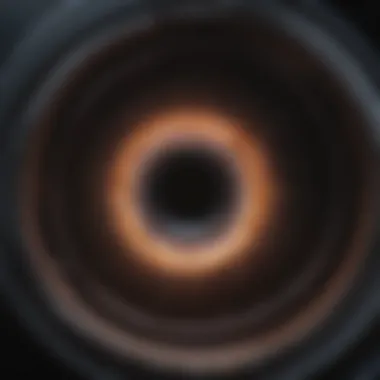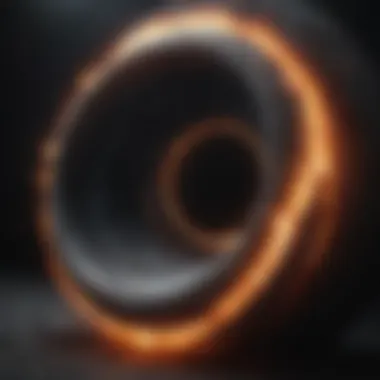Exploring Black Hole Imagery: Science and Significance


Intro
The visualization of black holes has captured the imagination of both scientists and the general public. These astronomical entities, known for their extreme gravitational pull, are pivotal in understanding the cosmos. Scientists have made substantial progress in developing techniques to capture images of black holes, with the groundbreaking photo of the supermassive black hole in M87 being a recent example. This article explores various aspects of black hole imagery, including the methodologies, significance, and challenges involved.
Research Overview
Key Findings
Black holes were once only theoretical constructs, existing primarily in mathematical equations. Recently, technological advancements have finally allowed astrophysicists to produce the first direct image of a black hole's event horizon. The most notable findings include:
- The capability to observe the event horizon of a supermassive black hole.
- Insights into the environment surrounding black holes, yielding valuable information about galactic formations.
- Evidence supporting theories of general relativity, affirming extraordinary predictions about these cosmic giants.
Study Methodology
The methodologies employed in black hole imaging combine several technologies:
- Very Large Array (VLA): Utilizes a series of radio observatories to gather data across massive distances.
- Event Horizon Telescope (EHT): A system of radio telescopes located around the world that work together to form a virtual Earth-sized telescope.
- Advanced algorithms: These are used to synthesize the data collected from EHT to create a coherent image.
Background and Context
Historical Background
The concept of black holes was first introduced in the early 20th century, stemming from the equations derived by Albert Einstein. The term "black hole" itself was coined in 1967 by physicist John Archibald Wheeler. For decades, these phenomena existed primarily within the realm of theoretical physics until technological advancements transformed the field.
Current Trends in the Field
Today, black hole research is at the forefront of astrophysics. Key trends include:
- Increasing collaboration among global teams of astronomers.
- Development of improved imaging techniques and predictive simulations.
- Growing public interest and media coverage blending science and popular culture.
In summary, black hole imagery sheds light on fundamental questions about the universe. The images serve as a bridge, connecting complex scientific theories to public understanding, while inspiring further inquiry about the cosmos's mysteries.
Prelude to Black Holes
Black holes are one of the most intriguing phenomena in astrophysics. Understanding them involves delving into several complex concepts and theories. This section serves as an essential foundation. By exploring the fundamental aspects of black holes, readers can appreciate their significance within the larger scope of the universe and our ongoing quest for knowledge.
Definition and Formation
A black hole is defined as a region in space where the gravitational pull is so strong that nothing, not even light, can escape from it. The idea of a black hole originates from the concept of the event horizon, a boundary beyond which events cannot affect an outside observer. Formally, black holes can be classified into three main types: stellar, supermassive, and intermediate black holes.
Formation of black holes typically occurs through the gravitational collapse of massive stars. When a star exhausts its nuclear fuel, it can no longer support itself against gravitational forces. This results in a supernova explosion, where the outer layers are expelled, while the core collapses under its gravity. If the remaining mass is sufficient, it becomes a black hole.
Historical Context
The journey to understand black holes began with the insights of many scientists throughout history. Theoretical groundwork was laid as early as the 18th century with John Michell's ideas on "dark stars", which hinted at objects that could trap light. It was not until the 20th century that the work of Albert Einstein changed perceptions of gravity and space with his theory of general relativity. This theory predicts the existence of black holes based on the warping of spacetime.
In 1971, Stephen Hawking advanced this understanding with his work on Hawking radiation. He proposed that black holes could emit radiation due to quantum effects near the event horizon. This revolutionary idea further solidified black holes’ status as critical objects for astrophysical study.
Thus, the historical development of black hole theory highlights humanity's persistent effort to understand the cosmos. The scientific discourse surrounding black holes reflects broader challenges facing the field of astrophysics. These aspects lay the groundwork for the detailed investigation of black hole imagery in the sections to follow.
Theoretical Framework


The theoretical framework surrounding black holes provides a foundation for understanding their nature and behavior. This section articulates crucial concepts that form the bedrock of astrophysical investigation into black holes. Understanding these principles allows researchers to delve deeper into cosmic phenomena and the implications of black holes in our universe. This framework is vital in connecting theoretical predictions with observational evidence.
Einstein's General Relativity
Einstein's General Relativity represents a monumental shift in understanding gravity. Proposed in 1915, it posits that gravity is not merely a force but a curvature of spacetime caused by mass. Black holes, as regions where mass is concentrated to an extent that nothing, not even light, can escape, offer a profound application of this theory. The significance of Einstein's work lies in its ability to predict the existence of black holes as a natural consequence of his equations. The solutions to his equations suggest that if a star collapses beyond a certain critical threshold, it will form a black hole. This understanding has propelled subsequent research in astrophysics and has crucial implications for the study of cosmic phenomena such as gravitational waves.
Hawking Radiation
Hawking Radiation introduces a paradox into the nature of black holes, challenging the traditional understanding derived from general relativity. Proposed by Stephen Hawking in 1974, this theory suggests that black holes can emit radiation due to quantum effects near the event horizon. As a result, black holes are not completely black; they can lose mass and energy over time. This phenomenon raises profound questions about thermodynamics and information loss in black holes. It also leads to implications that involve the lifecycle of black holes, suggesting that they can evaporate entirely. Understanding this radiation aids in reconciling quantum mechanics with general relativity, a critical endeavor in modern physics.
Event Horizon and Singularity
The event horizon marks the boundary of a black hole, beyond which nothing can escape the gravitational pull. This concept is crucial in studies of black holes as it delineates the point of no return for any matter or radiation. The singularity, on the other hand, is the core of a black hole where density becomes infinite, and the known laws of physics break down. Speculation regarding the conditions at the singularity raises philosophical and scientific inquiries about the universe and its laws. The study of event horizons and singularities is essential for theoretical physicists seeking to formulate a unified description of the forces governing the universe.
"Understanding the event horizon helps us comprehend the boundary between the known and unknown realms of black holes, posing challenges that continue to intrigue scientists today."
The theoretical framework surrounding black holes not only enhances our grasp of these mysterious cosmic giants but also stimulates ongoing research to unlock the secrets of the universe. It equips researchers with critical insights that bridge theoretical constructs with observational findings.
The First Image: A Milestone in Astrophysics
The capture of the first black hole image in 2019 was a significant achievement in the field of astrophysics. This image has not only provided visual confirmation of the existence of black holes but also has paved the way for further advancements in our understanding of the universe. It symbolized years of collaboration and technological advancements, highlighting the intersection between science and engineering.
The Event Horizon Telescope
The event horizon telescope (EHT) is a network of radio observatories strategically placed around the world. This global collaboration allowed astronomers to observe the black hole at the center of the galaxy M87. By linking together multiple telescopes, EHT achieved a resolution comparable to a telescope the size of Earth. This ingenuity enhances our ability to study black holes. The EHT represents a breakthrough in observational astronomy.
Technical Challenges
Data Collection
Collecting data with the EHT posed significant challenges. Astronomers had to gather vast amounts of information across various radio frequencies. The process required synchronizing observations across multiple sites, which demanded precise timing and coordination. The most critical aspect of data collection was its ability to capture high-resolution images of the black hole's shadow, emphasizing faint signals that originated from vast distances. This method is beneficial because it allows scientists to gather extensive datasets necessary for image reconstruction. However, the challenge lies in managing and transferring the large quantities of data rapidly.
Image Processing
Image processing entails the complex procedure of reconstructing the image from the collected data. This involves advanced algorithms to handle the noise and gaps in the data. The unique feature of image processing in this case was the use of very long baseline interferometry (VLBI), which combined observations from multiple radio telescopes. This approach enhances the clarity and detail of the final image. Nonetheless, the computational intensity of this processing can be a disadvantage, often requiring significant time and resources before yielding results.
Significance of the Image
The first black hole image serves as a key milestone in validating the theories of general relativity. It offers an unprecedented glimpse into the nature of these enigmatic objects. This image has profound implications, not only for astrophysics but also for understanding the fundamental physics governing the universe. Furthermore, it sparks curiosity and engages both the scientific community and the lay public. This engagement is crucial, as it promotes a broader appreciation for scientific inquiry and the complexities of our universe.
Speaking to its impact, researchers have noted:
"This image is more than just a photograph; it opens up a new era in astrophysics."
The significance of this milestone can not be understated, as it informs future inquiries into the behavior of matter under extreme gravitational forces and the role of black holes in galaxy formation and evolution. Through these efforts, a path is forged toward deeper insights into the cosmos.
Comparative Analysis of Black Hole Images
The comparative analysis of black hole images holds significant value in understanding these enigmatic cosmic objects. By examining various methods used to visualize black holes, researchers can assess their effectiveness and limitations. Such comparisons provide insights into the intricate nature of black holes and how they might behave in different contexts across the universe. Moreover, this analysis aids in setting the stage for future research, enhancing our understanding of astrophysical phenomena.
Different Methods of Visualization


Radio Astronomy
Radio astronomy stands as a crucial method for studying black holes. This approach primarily relies on detecting radio waves emitted or influenced by matter surrounding a black hole. One significant aspect of radio astronomy is its ability to observe objects regardless of the intervening cosmic dust, which often obstructs optical wavelengths. This makes it a beneficial choice for black hole imaging.
A key characteristic of radio astronomy is its ability to provide information about the dynamics of matter in the vicinity of black holes. For example, the Event Horizon Telescope utilized radio observations from multiple global sites, effectively creating a very-long-baseline interferometry setup. This technique allowed researchers to synthesize a high-resolution image of the black hole at the center of the galaxy M87.
However, radio astronomy does have its disadvantages. The process of data collection is intricate and can lead to challenges in image processing. Complex algorithms must be employed to synthesize the data accurately. Despite this, the unique features and capabilities of radio astronomy significantly contribute to our understanding of black holes.
Gravitational Wave Detection
Gravitational wave detection introduces another dimension in the observation of black holes. This method focuses on measuring the ripples in spacetime caused by massive celestial events, such as black hole mergers. The detection of these waves has opened new avenues for astrophysical research, offering a unique glimpse into regions of spacetime that traditional imaging cannot access.
A prominent aspect of gravitational wave detection is its ability to unveil information about the properties of black holes, such as their masses and spins during merger events. The LIGO Observatory is well-known for its pivotal role in detecting these waves, marking a groundbreaking achievement in modern astrophysics.
While the potential of gravitational wave detection is noteworthy, it is not without limitations. The technology requires highly sensitive instruments and substantial periods of observational time to gather valuable data. This means that while it provides insights into black hole events, it cannot contribute directly to the imaging of static black holes like the event horizon. Nevertheless, the strength of this method lies in its complementary nature alongside traditional imaging techniques.
Interpretation of Findings
The interpretation of findings from diverse imaging methods enables scientists to develop a nuanced understanding of black holes. Each method, whether radio astronomy or gravitational wave detection, contributes unique data that, when synthesized, enhances our overall knowledge. Analyzing the various implications and outcomes of these findings is critical for advancing our comprehension of astrophysical phenomena and the fundamental laws of the universe.
To note, understanding these approaches not only helps unravel the secrets of black holes but also provides insights into the fabric of spacetime itself.
This comparative analysis thus not only highlights individual methodologies but also emphasizes the importance of an integrated approach to studying black holes in the vast cosmos.
Implications for Astrophysics
Black hole imagery offers profound implications for the field of astrophysics. It creates a bridge connecting theories with observable phenomena. Understanding black holes allows scientists to refine existing models of the universe and generate new hypotheses. The images serve as a solid foundation for analyzing cosmic structures and events, warranting in-depth study and consideration.
Understanding Galaxy Formation
Black holes play a pivotal role in the formation and evolution of galaxies. They act as anchor points around which galaxies develop. As matter falls into a black hole, it releases energy in the form of radiation. This radiation can affect surrounding gas clouds, leading to star formation or inhibiting it altogether. The presence of supermassive black holes at galactic centers may define the structure and dynamics of entire galaxies.
Research into black holes has enhanced our comprehension of how galaxies coalesce. When researchers analyze black hole images, they can trace back the processes that led to the creation of these massive entities. Observations show correlations between black hole mass and galaxy characteristics, such as size and shape. Such findings suggest a complex interplay where black holes influence their host galaxies, making them critical to understanding cosmic evolution.
The Role of Black Holes in Cosmology
Black holes also contribute significantly to cosmological models, influencing our understanding of the universe's origin and fate. They help scientists probe concepts such as dark matter and dark energy. The mysterious nature of black holes allows for discussions about the fundamental aspects of spacetime.
A comprehensive analysis of black hole images provides insights into the early universe. For instance, studying the formation of primordial black holes can shed light on conditions shortly after the Big Bang. Additionally, black holes can serve as tools for observing cosmic expansion over time. Their growth patterns can reflect the universe’s expansion history and the effects of gravity on cosmic structures.
"Black holes are not just end points of stellar evolution; they are integral to the functioning of the universe itself."
In summary, the implications for astrophysics emerging from black hole studies are immense. They span critical areas of galaxy formation and cosmological inquiry. By advancing our understanding of these phenomena, the images of black holes reveal the extensive dynamics at play within the universe, illuminating our journey in astrophysical research.
Public Perception of Black Hole Images
Public perception of black hole images plays an essential role in bridging the gap between complex scientific theories and the general populace. The fascination that these visualizations evoke can impact science education, public engagement with astrophysics, and funding for future research. Understanding this perception requires a multifaceted approach that considers media influence, cultural implications, and the overarching narratives that surround black holes.
Media Representation
In the age of information, media representation shapes our understanding of scientific phenomena. The first image of a black hole, released by the Event Horizon Telescope in April 2019, marked a defining moment in scientific communication. Various news outlets used this image to illustrate concepts of gravity and spacetime, dramatically transforming black holes from abstract ideas into tangible entities.


The media's portrayal of black holes often emphasizes their dramatic and mysterious nature. Terms used include "monster in the universe" or "cosmic vacuum cleaners." While these descriptions capture public imagination, they can also mislead. The intricacies of black hole science get overshadowed by sensationalism.
Additionally, documentaries and educational programs have also played a critical role in public perception. For instance, shows like "Cosmos" or the science sections of platforms like National Geographic have explored black holes, integrating visuals with comprehensive explanations. This method provides a deeper understanding of the science while captivating viewers.
Science Communication Challenges
Communicating the complexities of black hole research presents unique challenges.
- Complex Terminology: Terms like "event horizon" or "singularity" can be daunting to lay audiences. Effective communication must demystify these concepts, making them accessible without oversimplifying.
- Visual Representation: The actual nature of black holes contrasts starkly with their representations. The famous image showcases a shadow surrounded by glowing gas. However, it suggests more clarity than exists in the scientific community regarding black holes’ comprehensions. Thus, striking a balance between accurate portrayal and generating interest is critical.
- Misinformation: In today's digital landscape, misinformation can spread surprisingly fast. Thus, scientists and communicators must be vigilant against oversimplifications that lead to misconceptions.
- Cultural Skepticism: Some audiences remain skeptical about scientific findings, often driven by personal beliefs or misinformation. Addressing concerns openly can help bridge gaps in understanding and improve overall perceptions.
In summary, effectively addressing public perception of black hole images is necessary for advancing both public interest and scholarly pursuit in astrophysics.
"Public interest can drive funding and attention to scientific exploration, impacting the direction of future research greatly."
As technology evolves and new generations of researchers emerge, the responsibility of crafting informed narratives remains vital.
Future Directions in Black Hole Research
The future of black hole research holds great promise and potential for expanding our understanding of the universe. As technology advances, researchers can expect significant breakthroughs that can enhance our capacity to visualize and comprehend black holes. This section looks at the cutting-edge technological innovations and the anticipated emergence of the next generation of observatories. These developments are crucial for both uncovering the mysteries still surrounding black holes and refining our theoretical frameworks.
Technological Innovations
Recent years have seen remarkable advancements in technology that offer new avenues for discovering and studying black holes. One key area is the improvement in imaging techniques. The Event Horizon Telescope's success has paved the way for future projects that harness similar methods but with enhanced capabilities.
Adaptive optics and new interferometric techniques enable astronomers to capture clearer, more detailed views of black holes. The integration of machine learning into data analysis is also transforming the field. This technology can quickly process vast amounts of data, increasing efficiency and accuracy in image reconstruction.
Additionally, developments in high-energy particle detection will allow scientists to examine black holes through new lenses. When black holes consume matter, they release enormous amounts of radiation, which present new signatures for detection purposes. Understanding these signatures can provide insight into the behavior of black holes and the environment surrounding them.
Innovations in technology not only boost our capability to visualize black holes, but also impact the broader fields of astrophysics and cosmology.
The Next Generation of Observatories
Currently, several ambitious projects are underway to construct the next generation of observatories. These facilities aim to further probe the nature of black holes and their role in the universe. One notable installation is the Square Kilometre Array (SKA), which will comprise thousands of antennas to observe radio wavelengths from space.
The SKA has the potential to explore areas that were previously inaccessible. This immense array can analyze faint signals often drowned out by cosmic noise. Similarly, aspiring developments such as the James Webb Space Telescope aim to provide unprecedented views into the cosmos, helping researchers focus on black holes during the early universe's epoch.
The emergence of gravitational wave observatories represents another pivotal chapter. Facilities like LIGO and Virgo detect ripples in spacetime caused by cosmic events such as black hole mergers. As these observatories become more sensitive, they will contribute to our understanding of black hole properties and their formation processes.
Ending
The exploration of black holes and the imagery associated with these cosmic phenomena is crucial in the contemporary field of astrophysics. This area of study not only reveals the nature of black holes but also enhances our understanding of underlying physical principles and their roles in the universe. In this article, we highlighted several key insights in this domain, demonstrating that capturing black hole images represents an unprecedented convergence of theoretical physics and cutting-edge technology.
Summary of Key Insights
Throughout the sections of this article, we have examined significant aspects of black hole imagery:
- The foundational theories underpinning black holes, such as Einstein's General Relativity and Hawking Radiation.
- The groundbreaking efforts of the Event Horizon Telescope and the challenges faced in imaging a black hole.
- The diverse methodologies employed to visualize these cosmic objects, including radio astronomy and gravitational wave detection.
- The implications of black hole research for understanding galaxy formation and cosmological phenomena.
- Public perception shaped by media representation and the importance of effective science communication.
These insights collectively contribute to a more nuanced understanding of not only black holes but also the universe as a whole.
Reiterating the Importance of Black Hole Research
Research into black holes is vital for several reasons. First, it prompts reevaluation of existing theories and encourages scientific inquiry into uncharted territories of physics—specifically in the realms of quantum mechanics and relativity. Second, black holes serve as natural laboratories for testing fundamental theories. They present conditions that cannot be replicated on Earth, allowing scientists to observe physical laws in extreme environments.
Moreover, the significance of black hole imagery extends beyond academic interest. The images capture the public imagination and reflect humanity's quest to understand the cosmos. They foster a dialogue between the scientific community and society at large, emphasizing science as an endeavor that is relevant to all.
Engaging deeply with this subject fosters appreciation for the complexities and wonders of the universe. The continual evolution of black hole research promises to unveil further mysteries, enhancing our existing knowledge and possibly challenging our basic tenets of understanding.







